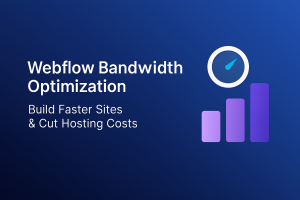In today’s digital world, creating a professional website doesn’t require coding skills anymore. Thanks to platforms like Webflow, even beginners can design and launch stunning, responsive websites with ease.
But what exactly is Webflow, and why has it become so popular among designers, marketers, and business owners?

What is Webflow?
Webflow is an all-in-one web design and development platform that allows users to visually create websites without writing code. It bridges the gap between design and development, giving complete creative control to designers while generating clean, production-ready HTML, CSS, and JavaScript in the background.
Unlike traditional website builders, Webflow focuses on flexibility, professional-grade design tools, and performance—making it ideal for everything from simple landing pages to full business websites.
Key Features of Webflow
- Visual Web Design: Build websites using a drag-and-drop interface while keeping full control over layout, styles, and animations—similar to designing in tools like Figma or Photoshop.
- CMS (Content Management System): Webflow’s CMS lets you create and manage dynamic content such as blogs, portfolios, team pages, and more without plugins.
- Hosting and Performance: Webflow offers fast, secure, and scalable hosting with built-in SSL, backups, and automatic updates—no server maintenance needed.
- SEO-Friendly Tools: You can easily add meta tags, alt attributes, clean URLs, and sitemaps to ensure your site is search engine optimized.
- Responsive Design: Design once and customize for different screen sizes—desktop, tablet, and mobile—with ease.
- Ecommerce Functionality: Build a fully customized online store with Webflow’s native ecommerce tools—no third-party apps required.
Who Can Benefit from Webflow?
Webflow is ideal for:
- Designers who want to turn static mockups into live websites.
- Startups and small businesses needing fast, beautiful sites.
- Marketers looking for landing pages with SEO and content control.
- Agencies building client projects with scalable workflows.
Whether you’re a freelancer, entrepreneur, or part of a creative team, Webflow offers a modern, no-code solution to build custom websites that stand out.
Webflow vs Other Platforms
- Webflow vs WordPress: While WordPress is plugin-based and often needs development knowledge, Webflow is visually intuitive and avoids bloat.
- Webflow vs Wix/Squarespace: These platforms are user-friendly but limited in design freedom. Webflow gives you more customization and cleaner output.
Final Thoughts
Webflow empowers users to design, build, and launch websites visually—without writing code. It combines the flexibility of custom development with the simplicity of drag-and-drop tools.
If you’re looking to create a future-ready, professional website that performs well and looks exactly how you want, Webflow is a platform worth exploring—no matter what year it is.
👉 Looking to get your website built? Hire a Webflow developer from our expert team.




